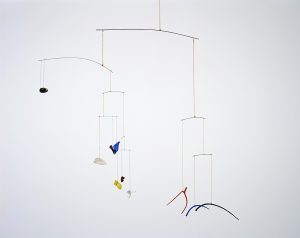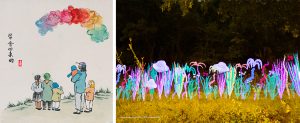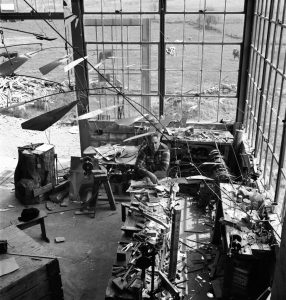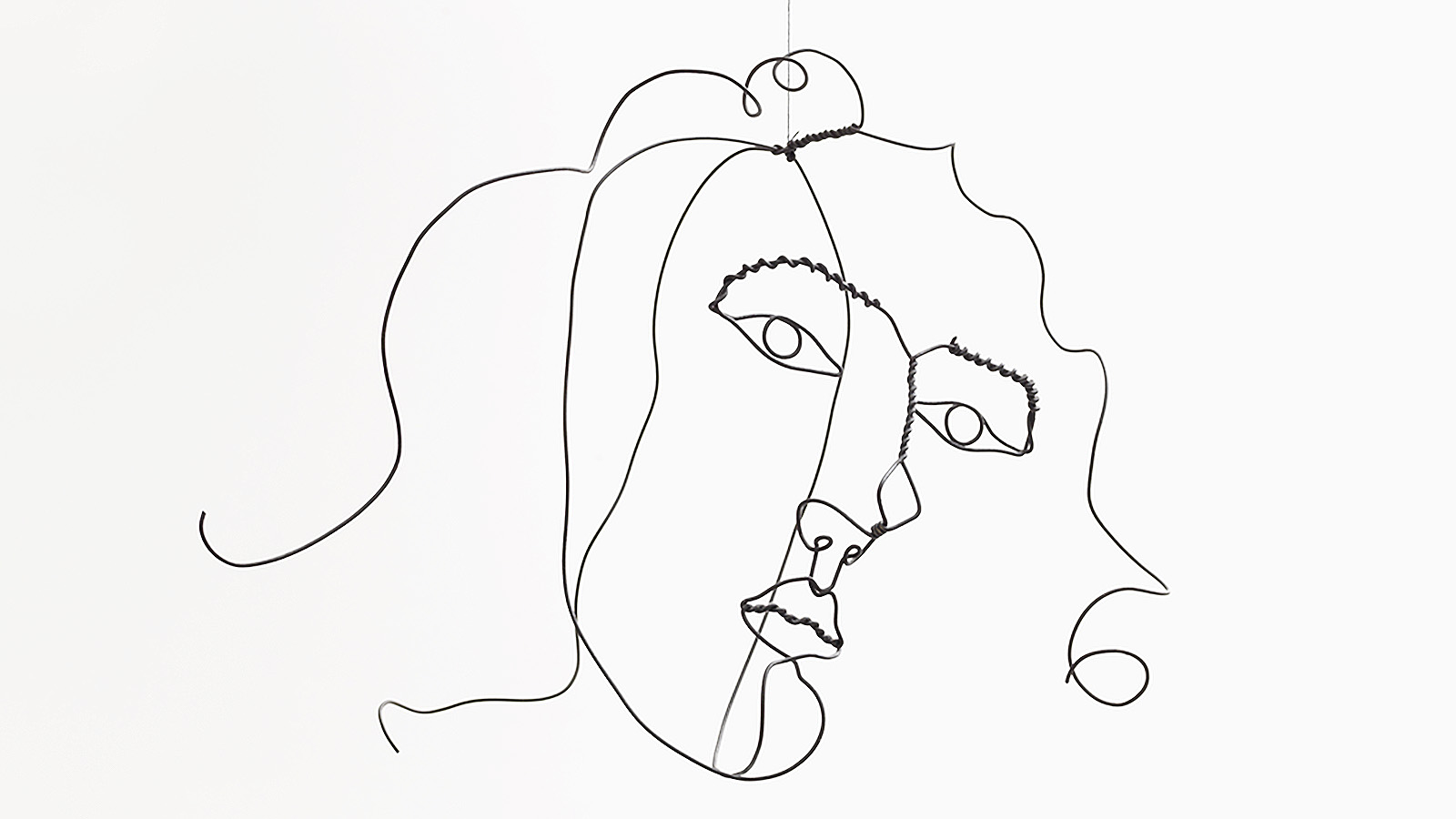Alexander Calder’s mobiles beg for interaction. Fashioned out of pop-colored sheet metal plates and wire, and engineered for balance, his famed hanging sculptures are kinetic creations, ready to respond to wind, air currents, and even the light nudge of a viewer. “They’re meant to be touched delicately,” he said in 1973. “I like the whang they make — noise is like another dimension.”
But as the sculptor’s work has arrived at the status of art object (and quite rightly so), his mobiles have become museum staples, installed in exhibitions where interaction is limited. “Engaging with the artwork itself is ideal,” Alexander S. C. Rower, President of the Calder Foundation and Calder’s grandson, tells Jing Culture & Commerce. “But when it’s in a vitrine or behind a stanchion, you can’t really have the access that Calder intended.”

“We have been very intentional about how digital art can reveal new possibilities utilizing my grandfather’s sculptures,” says Alexander S. C. Rower, President of the Calder Foundation and Calder’s grandson. Image: Alexander Calder, “Tines” (1943) / © 2022 Calder Foundation, New York / Artists Rights Society (ARS), New York
Not so much in the digital sphere. The Calder Foundation, which presides over Alexander Calder’s art and archives, has ensured the artist and his legacy virtually accessible presences — for one, it unveiled an online repository in 2021. But with the forthcoming Calder Question, a NFT art experience built around Calder’s oeuvre, the organization is fully intent on deepening the way audiences engage with its collections, to the point of “getting inside a sculpture,” says Rower.
Spearheaded by digital collecting platform TRLab and due to launch in the fall, the Calder Question will present “an educational online journey” through the artist’s signature forms, namely his mobiles, early abstractions, figurative sculptures, and sound works. These interactive encounters are accompanied by a gamified aspect, wherein visitors can participate in collaborative activities and challenges for the chance to win physical rewards or collect NFTs created exclusively for the platform.
For TRLab, this centering of education anchors its broader goal of enriching digital collecting. “One of our core beliefs at TRLab is that access and education should be integrated into the act of collecting,” says Xin Li-Cohen, Co-Founder and Chairwoman of TRLab, “and we consider those to be core utilities in every project we build.” Accordingly, the Calder Question maximizes the utility and interactivity of Web3 to elevate an audience’s understanding of a body of work, while creating a shared experience. To Audrey Ou, CEO and Co-Founder of TRLab, “This is an inkling of what’s to come with the next-generation application of NFT technology, where NFTs can be still images or art, but they can also be tokens in a collective experience and in this case, signifiers of knowledge.”
And TRLab already has receipts on how such a project, hinging on access and education, could grow a vibrant collector community. Earlier this year, the platform launched Your Daytime Fireworks by Cai Guo-Qiang, the Chinese artist and gunpowder master. While TRLab partnered with Cai for his earliest NFT collections, Transient Eternity and Exploding The Self 2021, his latest outing, per Ou, looked to “pioneer a new way of collecting.”

Your Daytime Fireworks invited collectors to purchase a firework packet, which could be set off to reveal one of 90 artworks by Cai Guo-Qiang. Image: Courtesy of TRLab
Over 45 days in April, collectors could purchase a firework packet token and “set it off” at a date and time of their choosing to reveal one of 90 artworks. These digital firework variants were contingent on a collector’s location and the day’s weather conditions — factors that made for the kind of uncertainty and anticipation that the explosives artist himself would experience ahead of his firework performances. According to Ou, Cai’s hope was for collectors to “undertake their own exploration and participation,” in turn gaining a first-hand, albeit virtual, perspective of his practice.
All 7,000 editions of Your Daytime Fireworks were sold out within 62 seconds of launch and the experience is in the running for the NFT Award at the 2022 Lumen Prize. But the project’s success can as much be located in the community that has sprung up around it. In a clear understanding of the power of the public, Cai was eager to engage with fans, wishing them “GM” on Discord, participating in online AMAs, and sharing images from his daily life. At the Cartier Art Dialogues in May, he shared fan art that his NFT holders had created around the collection. As Ou reflects, “There is a global community that’s very hungry for a strong, intimate connection with the artists and to learn about their practice in a very genuine way.”

Fan art created by Your Daytime Fireworks holder Shaoxia. Image: Courtesy of TRLab
To that end, Ou also underscores TRLab’s push to integrate these online projects with IRL experiences, granting the kind of exclusive access sought after by NFT holders. For Your Daytime Fireworks, it’s already hosted two tours of Cai’s New York and New Jersey studios — “a return to the meaning of art and long-term value,” in her words. With the Calder Question, a select group of participants who complete all levels of the experience will get to join a private tour of the artist’s studio and private residence in Roxbury, Connecticut.
This narrowing of the gap between creator and collector, as Li-Cohen points out, has been made real by Web3. “Our goal is to leverage the capabilities of blockchain technology in a way that enriches the connection between the artist and the collector,” she emphasizes, “and in a way that traditional art forms can’t.” And there’s every indication that artists and artist estates are looking to Web3 for tools and communities that in turn might transform both traditional practices and collecting approaches.

The Calder Question will offer an “educational online journey” into Calder’s body of work. Image: Calder in his Roxbury studio, 1947. Photograph by Herbert Matter © 2022 Calder Foundation, New York
NFT collectors, says Li-Cohen, “are now very focused on finding projects and artists they can connect with on both an intellectual and aesthetic level.” Likewise, Ou notes a positive shift in how traditional artists and cultural institutions view the promise of Web3. “If you told me last year at this time that the Calder Foundation would be interested in talking to us about NFTs, I’d say absolutely no way,” she adds. “The fact that we’re getting to partner with them now that they’re looking forward, I think that’s an attitude that a lot of traditional art institutions are taking.”
For Rower at the Calder Foundation, this “looking forward” with NFTs represents new avenues for today’s audiences to interact with Calder’s work as much as for Calder’s legacy to engage with the 21st century. Like the “whang” of interaction, Web3 spawns for artist and viewer alike a whole other dimension. “Calder was a disruptor, a pioneer in perception who continually reinvented ways to communicate his ideas,” he says. “I believe if he were alive today that he would be energized by the multidimensionality of this moment.”



